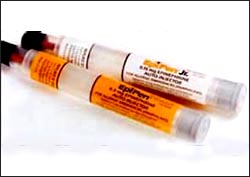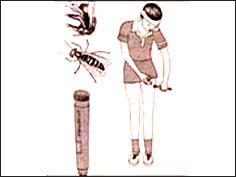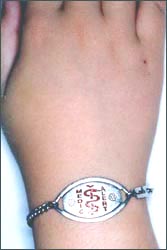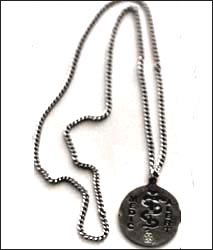약물로 생긴 아나필락시스 반응(약물 과민증), Anaphylaxis caused by drugs
- 아나필락시스 반응은 항원 항체 이상 반응으로 생기는 급성 알레르기 질환 중 하나이다.
- 아나필락시스 반응을 즉시 적절히 치료하지 않으면 사망할 수 있다.
- 아나필락시스 반응을 과민증, 또는 과민이라고도 한다.
약물로 생긴 아나필락시스 반응의 원인
- 페니실린·코티손·인슐린·예방접종 백신·그 외 여러 종류의 약물로 치료받을 때 아나필락시스 반응이 생길 수 있다.
- 약물을 경구로 섭취하거나, 피부나 점막에 바르거나, 코나 입을 통해서 기도 속으로 흡입하거나 기도 속에 뿜거나, 혈관주사로 맞거나 근육주사로 맞거나, 항문 속이나 질 속에 좌약을 넣고 치료하거나, 또는 그 외 다른 방법으로 약물 치료를 받을 때 약물로 아나필락시스 반응이 생길 수 있다.
- 아나필락시스 반응이 약물치료를 받은 후 불과 몇 초 내, 또는 몇 시간 이내 생기는 것이 보통이다.
- 아나필락시스 반응이 약물 알레르기로도 생길 수 있고, 땅콩·견과류·달걀·우유·조개, 새우 등 음식물을 섭취할 때도 생길 수 있고, 벌·곤충에 쏘이거나, 동물에 물려도 아나필락시스 반응이 생길 수 있다.
- 집 먼지 좀 진드기, 짐승의 비듬, 털이나 침, 또는 초목의 꽃가루를 흡입해도 그로 인해 아나필락시스 반응이 생길 수 있다.
약물로 생긴 아나필락시스 반응의 참조문헌 및 출처
- [부모도 반의사가 되어야한다-소아가정간호백과]-제 1권 소아청소년 응급의료-아나필락시스 반응 참조.
- 혈청병
- 벌 알레르기
- 우유 단백질 알레르기 질환의 진단
- 페니실린 알레르기
- 곤충 자상 참조
약물로 생긴 아나필락시스 반응의 증상 징후
- 비만세포(Mast cells)는 뇌하수체와 신체 여러 계통의 여러 기관과 조직에 정상적으로 많이 있다.
- 히스타민은 신체 각 부위에 산재해 있는 비만세포 내, 뇌하수체의 비만세포 내, 호염기성 세포 내 과립상태로 있다.
- 히스타민은 비만세포 탈 과립과정에 의해 비만세포막의 밖으로 정상으로 분비된다. p.00 알레르기를 일으키는 기전 그림 참조
- 항원 항체 이상 반응이 생기면 비만 세포에서 히스타민이 다량으로 갑자기 분비된다.
- 그 히스타민은 신체 내 다른 종류의 생화학 물질들-IgE, 사이토카인(Cytokines), 프로스타글란딘(Prostaglandin), 류코트리엔(Leukotrienes) 등과 복합적으로 작용할 수 있다. 이때 아나필락시스 반응이 일어날 수 있다.
- 아나필락시스 반응의 증상 징후는 일률적으로 나타나지 않고 다양하다.
- 그때그때에 따라 생명을 위협할 수 있을 정도로 위중할 수도 있고 경미할 수도 있다.
- 경미할 때는 피부가 조금 가려운 정도로 증상 징후가 생길 수 있다.
- 심할 때는 전신 피부와 점막층이 발적 되고, 붓고, 두드러기가 날 수 있고
- 구토·설사·복통 등 증상을 동반한 소화기 장애가 생길 수 있다.
- 콧물·기침·기관지 천식·천명 협착음·청색증·호흡부전증 등의 호흡기 질환으로 생길 수 있는 증상 징후가 생길 수 있다.
- 혈압이 갑자기 떨어질 수 있고 호흡곤란이 심하게 생길 수 있으며 심지어는 쇼크에 빠져 죽을 수도 있다.
약물로 생긴 아나필락시스 반응의 진단
- 병력·증상 징후·진찰소견 등을 종합해서 진단할 수 있다.
- 환아 자신이나 부모, 형제자매 중 누구에게 아토피 체질이 있거나 알레르기 질환이 있는 가족병력이 있으면 진단하는 데 도움이 된다.
- 아나필락시스 반응이 일어나기 바로 전 아나필락시스 반응을 유발할 수 있는 약물(항원) 등을 경구로 섭취했거나 몸에 바르거나 주사로 맞거나 비강 속이나 기도 속으로 흡입한 사실이 있으면 진단하는데 도움이 된다.
- 약물, 음식물, 또는 그 밖에 다른 항원에 접촉된 사실이 있거나 앞서 설명한 여러 가지 증상 징후가 있을 때 아나필락시스 반응을 비교적 쉽게 진단할 수 있다.
- 그렇지만, 약물로 생긴 아나필락시스 반응의 증상 징후가 항상 일률적으로 뚜렷하게 나타나지 않기 때문에 약물로 생긴 아나필락시스 반응을 금방 확실히 진단하기가 어려운 때도 있다.
- 드물게, 약물로 치료받지도 않고 특이한 음식물을 섭취하지도 않고, 곤충에 물리거나 쏘인 적도 없는데 아나필락시스 반응이 생길 수 있다.
- 또 어떤 병의 증상 징후가 아나필락시스 반응으로 생긴 증상 징후와 거의 비슷하게 나타날 수 있다.
- 그래서 약물로 생긴 아나필락시스 반응의 증상 징후와 다른 병으로 생긴 증상 징후가 비슷할 수 있다.
- 이때 다른 병으로 생긴 증상 징후와 아나필락시스 반응으로 생긴 증상 징후를 감별 진단해야 한다.

사진 55. 심하게 생긴 아나필락시스 반응을 응급으로 치료할 때 쓸 수 있는 에피네프린 성분이 든 에피펜 자가주사기 주사약 사진.
에피펜의 주성분은 에피네프린이다.

그림 56. 벌 알레르기가 생기면 환아 자신이나 주위 사람이 에피펜 자가주사기 주사약으로 응급치료를 할 수 있다.
Copyright ⓒ 2013 John Sangwon Lee, MD., FAAP

사진 57. 어떤 종류의 약물이나 그 외 것으로 인해 심한 알레르기 반응이 있었으면 그런 심한 알레르기 반응이 있다는 병력을 남에게 알려줄 수 있는 글 표식 팔찌를 끼고 다닌다.
Copyright ⓒ 2013 John Sangwon Lee, MD., FAAP

사진 58. 심한 약물 알레르기나 무엇에 알레르기 반응이 있었다는 글 표식 목걸이를 걸고 다닌다.
Copyright ⓒ 2013 John Sangwon Lee, MD., FAAP
약물로 생긴 아나필락시스 반응의 치료
- 아나필락시스의 중증도(Severity)에 따라 다르게 치료한다.
- 심한 아나필락시스 반응이 생기면 즉시 현장에서 적절한 응급 치료를 시작해야 생명을 건질 수 있다.
- 때로는, 의사의 도움을 청할 겨를도 없이 즉시 응급 치료를 시작해야할 경우가 있다.
- 과거에 아나필락시스 반응이 심하게 생겼던 병력이 있는 아이들이 있으면 환아 본인이나 주위 사람이 즉시 응급 치료를 시작할 수 있도록 에피네프린 주사약이나 에피펜 자가주사기 주사약 또는 그에 상당한 응급처치 약을 항상 지참하고 있어야 한다.
- 에피네프린 주사약이 없을 때는 단골 소아청소년과 의사에게 긴급 전화 연락을 해 그의 지시에 따라 응급 치료를 그 현장에서 시작하고 가장 가까운 병원이나 응급실로 급히 이송해야 한다.
- [부모도 반의사가 되어야 한다-소아가정간호백과]-제 21권 소아청소년 가정간호-p.00 쇼크나 아나필락시스 반응 응급치료에 쓸 수 있는 에피네프린 주사약 참조
- 아나필락시스 반응의 중증도와 증상 징후에 따라 아나필락시스 반응을 산소호흡 치료, 생명유지 기본 심폐소생술 처치나 진보적 심폐소생술 처치로 치료해야 한다.
- 의사가 현장에 직접 와서 응급처치하는 방법이 가장 적절하고, 가장 안전하면 그렇게 한다.
- 그렇게 할 수 없으면 그 당시 가장 적절하고, 가장 안전하고, 가장 빠른 교통수단을 이용해 가장 가까운 동네 병원, 종합 병원 응급실로 환자를 이송한다.
- 아나필락시스 반응의 중증도에 따라 치료한다.
- 예를 들면, 심한 아나필락시스 반응은 에피네프린 주사·코르티코스테로이드제·산소호흡·혈압 상승제·기관지 확장제·항히스타민제·전해질용액 혈관 주사·진보적 심폐 소생술 등으로 병원 응급실에서 응급 치료하는 것이 보통이다.
- 경우에 따라 기관내관 삽입으로 산소 호흡 치료한다.
약물로 생긴 아나필락시스 반응의 예방
- 아나필락시스 반응을 일으켰던 약물, 음식물, 그 외 항원을 또다시 먹거나, 마시거나, 접촉하거나 주사로 맞는 것을 피해야 한다.
- 대부분 모든 종류의 약물은 아나필락시스 반응을 일으킬 가능성이 있다.
- 약물 치료를 받을 때는 의사의 처방이나 지시에 따라 약물을 써야 한다.
- 특히, 아토피 체질이 있는 아이들이 약물치료를 받을 때는 약물로 아나필락시스 반응이 생길 가능성이 더 많고, 약물 알레르기나 약물 부작용이 생길 가능성도 더 많다.
- 아나필락시스 반응이 생길 때 응급치료를 할 수 있는 에피펜이나 에피네프린 주사약 또는 그 외 아나필락시스 반응 응급처치용 주사약을 항상 준비하고 평소에도 지참해야 한다.
- 어떤 종류의 약물로 치료를 꼭 받아야 할 경우, 여러 종류의 약 성분이 섞인 종합 약물제로 치료하는 것보다 한 종류의 약물 성분으로 만든 단가 약물로 치료받도록 한다.
- 과거에 어떤 약물이나 그 외 어떤 것으로 인해 아나필락시스 반응이 생겼었다면 아나필락시스 반응을 일으켰던 약물 이름이 쓰인 목걸이나 팔찌를 항상 걸고 다니며 과거에 아나필락시스 반응을 일으켰던 약물이나 물질을 절대로 다시 쓰지 말아야 한다.
- 페니실린 아나필락시스 반응이 생겼던 사람들에게 페니실린이나 페니실린 화학 구조와 비슷한 화학 구조를 가진 페니실린 이외 약물에 의해서도 아나필락시스 반응이 생길 수 있다.
- 어떤 종류의 항생제나 다른 종류의 약물로 치료할 때는 의사의 지시에 따라 약물을 쓴다.
- 아토피 체질이 있는 아이들과 과거에 아나필락시스 반응이 생겼던 아이들은 가능한 한 처방해 준 약물로만 치료한다.
- 과거에 어떤 약물이나 벌독 알레르기 알레르기 등으로 아나필락시스 반응이 생겼던 아이들은 평소에 에피네프린 주사약이나 에피펜, 또는 아나키트를 지참하고, 그 아이가 사는 집, 다니는 학교, 타고 다니는 가정 승용차 등에 항상 보관했다가 아나필락시스 반응이 생길 때 본인이나 주위 사람이 에피펜 자가 주사기 주사약이나 그 외 에피네프린 주사약으로 현장에서 아나필락시스 반응을 치료하기 시작해야 한다. [부모도 반의사가 되어야 한다-소아가정간호백과]제 21권 소아청소년 가정간호-쇼크나 아나필락시스 반응의 응급치료에 쓸 수 있는 에피네프린 주사약 참조
- 주사 놓는 방법을 설명하는 시청 큐가 있는 에피네프린 자가 주사기(Epinephrine Auto-Injector)를 미 FDA가 인가했다. 의사의 처방에 따라 이를 이용해 치료 할 수도 있다. Physician’s First Watch for August 14, 2012
- 기관지 천식․알레르기 비염․아토피성 피부염 등 알레르기 질환이 있는 병력이 있는 아이들에게는 벌 알레르기 아나필락시스 반응이나 약물 아나필락시스 반응이 생길 가능성이 더 많다.
- 그런 아이들에게는 다른 종류의 약물에도 알레르기가 생길 가능성이 많으므로 어떤 종류의 약물을 쓸 때도 주의해야 한다.
Anaphylaxis caused by drugs (anaphylaxis)
• Anaphylactic reaction is one of the acute allergic diseases caused by an antigen-antibody abnormal reaction.
• An anaphylactic reaction can result in death if not treated promptly and appropriately.
• Anaphylactic reactions are also called hypersensitivity or hypersensitivity.
Causes of drug-induced anaphylactic reactions
• Anaphylactic reactions can occur when treated with penicillin, cortisone, insulin, immunization vaccines, and many other medications.
• Taking the drug orally, applying it to the skin or mucous membranes, inhaling it through the nose or mouth, or exhaling it into the airway, giving it a vascular or intramuscular injection, or injecting a suppository into the anus or vagina for treatment; Alternatively, the drug may cause an anaphylactic reaction when receiving drug treatment in other ways
• Anaphylactic reactions usually occur within seconds or hours of taking medication.
• Anaphylactic reaction can also be caused by drug allergy, and can also occur when eating foods such as peanuts, nuts, eggs, milk, shellfish, and shrimp, and anaphylactic reactions can also occur from bee or insect stings or animal bites.
• Inhalation of house dust mites, animal dander, hair or saliva, or plant pollen can also cause an anaphylactic reaction.
References and sources of drug-induced anaphylactic reactions
• www.drleepediatrics.com – Volume 1 Pediatric Emergency Medical Care – See Anaphylactic Reaction.
• Serum disease
• Bee allergy
• Diagnosis of milk protein allergy
• Penicillin allergy
• See insect stings Symptoms of a drug-induced anaphylactic reaction
• Mast cells are normally abundant in the pituitary gland and in various organs and tissues of various systems of the body.
• Histamine is in the granular state in mast cells scattered throughout the body, in mast cells in the pituitary gland, and in basophils.
• Histamine is normally secreted out of the mast cell membrane by the mast cell degranulation process. Mechanism of Allergies Refer to the picture
• When an antigen-antibody reaction occurs, a large amount of histamine is suddenly secreted from mast cells.
• The histamine can act in combination with other types of biochemicals in the body – IgE, cytokines, prostaglandins, leukotrienes, etc. An anaphylactic reaction may occur at this time.
• The symptoms of an anaphylactic reaction do not appear uniformly, but vary.
• Depending on the occasion, it may be serious or mild enough to be life-threatening.
• In mild cases, symptoms may occur to the extent that the skin is slightly itchy.
• In severe cases, the skin and mucous membranes all over the body may become red, swollen, and hives may appear.
• Digestive disorders with symptoms such as vomiting, diarrhea, and abdominal pain may occur.
• A runny nose, cough, bronchial asthma, wheezing, stenosis, cyanosis, and respiratory failure may cause symptoms and signs of respiratory disease.
• Your blood pressure may drop suddenly, you may have severe shortness of breath, or even die of shock.
Diagnosis of drug-induced anaphylactic reactions
• Diagnosis can be made by combining medical history, symptoms, signs, and examination findings.
• It is helpful in diagnosing if the patient himself or any of his parents or siblings has an atopic constitution or has a family history of allergic diseases.
• It is helpful for diagnosis if there is a history of oral ingestion, application to the body, injection, or inhalation into the nasal passages or airways of drugs (antigens) that can cause an anaphylactic reaction immediately before the anaphylactic reaction occurs.
• Anaphylactic reaction is relatively easy to diagnose when there is contact with drugs, food, or other antigens, or when there are several symptoms described above.
• However, it is sometimes difficult to quickly and definitively diagnose a drug-induced anaphylactic reaction because the symptoms of a drug-induced anaphylactic reaction do not always appear uniformly and distinctly.
• Rarely, an anaphylactic reaction can occur without being treated with medication, eating unusual foods, and never being bitten or stung by an insect.
• Symptoms of another disease may appear almost identical to those caused by an anaphylactic reaction.
• So, the symptoms of an anaphylactic reaction caused by a drug may have similar symptoms to those caused by other diseases.
• At this time, it is necessary to differentiate between the symptom signs caused by other diseases and the symptom signs caused by the anaphylactic reaction.

Photo 55. EpiPen auto-injector injection containing epinephrine can be used for emergency treatment of severe anaphylactic reactions. The main component of EpiPen is epinephrine.

Figure 56. When a bee allergy develops, the patient himself/herself or others around him/her can provide emergency treatment with the Epipen auto-injector injection. Copyright ⓒ 2013 John Sangwon Lee, MD., FAAP

Photo 57. If you have had a severe allergic reaction to any kind of drug or anything else, you wear an inscription bracelet to let others know of your history of such a severe allergic reaction. Copyright ⓒ 2013 John Sangwon Lee, MD., FAAP

Photo 58. She wears a necklace that says she has a severe drug allergy or allergic reaction to something. Copyright ⓒ 2013 John Sangwon Lee, MD., FAAP
Treatment of drug-induced anaphylactic reactions
• Treat differently depending on the severity of anaphylaxis. • In the event of a severe anaphylactic reaction, immediate on-site emergency treatment must be initiated to save lives.
• Sometimes, you need to start emergency treatment right away without even having to seek help from your doctor.
• If you have children with a history of severe anaphylactic reactions in the past, always have an epinephrine injection, EpiPen auto-injector, or equivalent first aid kit with you so that you or others around you can begin emergency treatment immediately.
• If you do not have epinephrine injections, you should make an emergency phone call to your regular pediatrician, follow his instructions, start emergency treatment on the spot, and immediately transport you to the nearest hospital or emergency room.
• [Parents should also become anti-doctors – Encyclopedia of Pediatric Home Nursing] – Vol. 21 Home Nursing for Children and Adolescents – See Epinephrine Injection for Emergency Treatment of Shock or Anaphylactic Reactions
• Depending on the severity and symptomatic signs of the anaphylactic reaction, the anaphylactic reaction should be treated with oxygen breathing therapy, life-sustaining basic CPR, or progressive CPR.
• If a doctor comes to the scene and provides first aid, it is the most appropriate and safest way to do so.
• If this is not possible, transfer the patient to the nearest local hospital or general hospital emergency room using the most appropriate, safest, and fastest means of transportation at the time.
• Treatment depends on the severity of the anaphylactic reaction.
• For example, severe anaphylactic reactions are usually treated in the emergency department of a hospital emergency room with epinephrine injections, corticosteroids, oxygen respiration, blood pressure boosters, bronchodilators, antihistamines, electrolytes, intravenous injections, and advanced cardiopulmonary resuscitation.
• In some cases, oxygen breathing treatment with endotracheal tube insertion.
Prevention of drug-induced anaphylactic reactions
• Avoid re-eating, drinking, contacting, or injecting any drug, food, or another antigen that caused the anaphylactic reaction.
• Most drugs of all kinds have the potential to cause anaphylactic reactions.
• When taking medication, you must use the medication according to your doctor’s prescription or instructions.
• In particular, when children with atopic constitution receive medication, they are more likely to develop an anaphylactic reaction to the drug and are more likely to develop drug allergy or drug side effects.
• Always have an EpiPen or epinephrine injection for emergency treatment in case of an anaphylactic reaction or other injections for an anaphylactic reaction and bring it with you at all times.
• If you absolutely need to be treated with a certain type of drug, instead of using a combination drug that contains multiple drug ingredients, you should be treated with a unit-priced drug made from one type of drug.
• If you have had an anaphylactic reaction in the past due to any drug or anything else, always wear a necklace or bracelet with the name of the drug that caused the anaphylactic reaction and never reuse the drug or substance that caused the anaphylactic reaction in the past.
• In people who have had penicillin anaphylactic reactions, anaphylactic reactions may also occur with penicillin or drugs other than penicillin, which has a chemical structure similar to that of penicillin.
• When treated with one type of antibiotic or another type of medication, use the medication as directed by your doctor.
• Children with atopic constitution and children who have had anaphylactic reactions in the past should be treated only with prescribed medications if possible.
• Children who have had an anaphylactic reaction due to an allergy to any drug or bee venom in the past usually bring an epinephrine injection, EpiPen, or AnakiT, and always keep it in the child’s house, school, or car they drive When an anaphylactic reaction develops, you or someone close to you should begin treating the anaphylactic reaction on-site with an EpiPen autoinjector or other injectable epinephrine. [Parents should also become anti-doctors – Encyclopedia of Pediatric Home Nursing] Vol. 21 Home Nursing for Children and Adolescents – Refer to Epinephrine Injection for Emergency Treatment of Shock or Anaphylactic Reactions
• FDA-approved Epinephrine Auto-Injector with viewing cues explaining how to inject. It can be used for treatment according to the doctor’s prescription. Physician’s First Watch for August 14, 2012
• Children with a history of allergic conditions, such as bronchial asthma, allergic rhinitis, or atopic dermatitis, are more likely to develop a bee allergy anaphylactic reaction or a drug anaphylactic reaction.
• Such children are more likely to be allergic to other drugs, so be careful when using any kind of drug.
출처 및 참조 문헌 Sources and references
- NelsonTextbook of Pediatrics 22ND Ed
- The Harriet Lane Handbook 22ND Ed
- Growth and development of the children
- Red Book 32nd Ed 2021-2024
- Neonatal Resuscitation, American Academy Pediatrics
- A SUPPLEMENT TO PEDIATRICS, SYNAPSIS BOOK, BEST ARTICLES RELEVANT TO PEDIATRIC ALLERGY, ASTHMA, IMMUNOLOGY, PEDIATRICS OFFICIAL JOURNAL OF THE AMERICAN ACADEMY.12/2019
- www.drleepediatrics.com 제1권 소아청소년 응급 의료
- www.drleepediatrics.com 제2권 소아청소년 예방
- www.drleepediatrics.com 제3권 소아청소년 성장 발육 육아
- www.drleepediatrics.com 제4권 모유,모유수유, 이유
- www.drleepediatrics.com 제5권 인공영양, 우유, 이유식, 비타민, 미네랄, 단백질, 탄수화물, 지방
- www.drleepediatrics.com 제6권 신생아 성장 발육 육아 질병
- www.drleepediatrics.com제7권 소아청소년 감염병
- www.drleepediatrics.com제8권 소아청소년 호흡기 질환
- www.drleepediatrics.com제9권 소아청소년 소화기 질환
- www.drleepediatrics.com제10권. 소아청소년 신장 비뇨 생식기 질환
- www.drleepediatrics.com제11권. 소아청소년 심장 혈관계 질환
- www.drleepediatrics.com제12권. 소아청소년 신경 정신 질환, 행동 수면 문제
- www.drleepediatrics.com제13권. 소아청소년 혈액, 림프, 종양 질환
- www.drleepediatrics.com제14권. 소아청소년 내분비, 유전, 염색체, 대사, 희귀병
- www.drleepediatrics.com제15권. 소아청소년 알레르기, 자가 면역질환
- www.drleepediatrics.com제16권. 소아청소년 정형외과 질환
- www.drleepediatrics.com제17권. 소아청소년 피부 질환
- www.drleepediatrics.com제18권. 소아청소년 이비인후(귀 코 인두 후두) 질환
- www.drleepediatrics.com제19권. 소아청소년 안과 (눈)질환
- www.drleepediatrics.com 제20권 소아청소년 이 (치아)질환
- www.drleepediatrics.com 제21권 소아청소년 가정 학교 간호
- www.drleepediatrics.com 제22권 아들 딸 이렇게 사랑해 키우세요
- www.drleepediatrics.com 제23권 사춘기 아이들의 성장 발육 질병
- www.drleepediatrics.com 제24권 소아청소년 성교육
- www.drleepediatrics.com 제25권 임신, 분만, 출산, 신생아 돌보기
- Red book 29th-31st edition 2021
- Nelson Text Book of Pediatrics 19th- 21st Edition
- The Johns Hopkins Hospital, The Harriet Lane Handbook, 22nd edition
- 응급환자관리 정담미디어
- Pediatric Nutritional Handbook American Academy of Pediatrics
- 소아가정간호백과–부모도 반의사가 되어야 한다, 이상원 저
- The pregnancy Bible. By Joan stone, MD. Keith Eddleman, MD
- Neonatology Jeffrey J. Pomerance, C. Joan Richardson
- Preparation for Birth. Beverly Savage and Dianna Smith
- 임신에서 신생아 돌보기까지. 이상원
- Breastfeeding. by Ruth Lawrence and Robert Lawrence
- Sources and references on Growth, Development, Cares, and Diseases of Newborn Infants
- Emergency Medical Service for Children, By Ross Lab. May 1989. p.10
- Emergency care, Harvey Grant and Robert Murray
- Emergency Care Transportation of Sick and Injured American Academy of Orthopaedic Surgeons
- Emergency Pediatrics A Guide to Ambulatory Care, Roger M. Barkin, Peter Rosen
- Quick Reference To Pediatric Emergencies, Delmer J. Pascoe, M.D., Moses Grossman, M.D. with 26 contributors
- Neonatal resuscitation Ameican academy of pediatrics
- Pediatric Nutritional Handbook American Academy of Pediatrics
- Pediatric Resuscitation Pediatric Clinics of North America, Stephen M. Schexnayder, M.D.
-
Pediatric Critical Care, Pediatric Clinics of North America, James P. Orlowski, M.D.
-
Preparation for Birth. Beverly Savage and Dianna Smith
-
Infectious disease of children, Saul Krugman, Samuel L Katz, Ann A.
- 제4권 모유, 모유수유, 이유 참조문헌 및 출처
- 제5권 인공영양, 우유, 이유, 비타민, 단백질, 지방 탄수 화물 참조문헌 및 출처
- 제6권 신생아 성장발육 양호 질병 참조문헌 및 출처
- 소아과학 대한교과서
Copyright ⓒ 2014 John Sangwon Lee, MD., FAAP
“부모도 반의사가 되어야 한다”-내용은 여러분들의 의사로부터 얻은 정보와 진료를 대신할 수 없습니다.
“The information contained in this publication should not be used as a substitute for the medical care and advice of your doctor. There may be variations in treatment that your doctor may recommend based on individual facts and circumstances.
“Parental education is the best medicine.